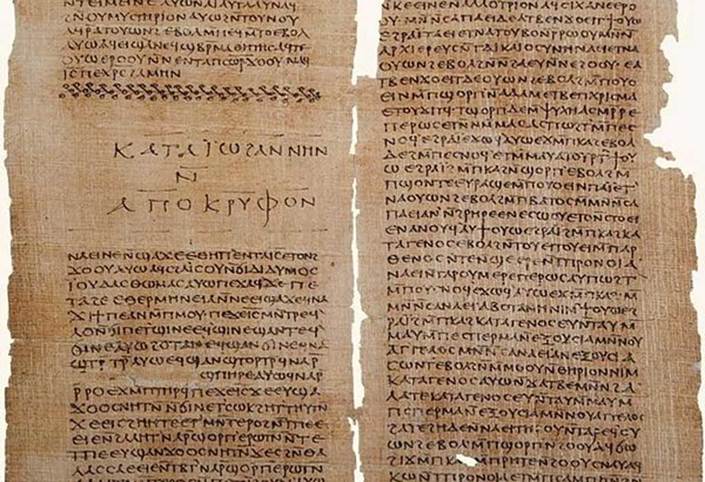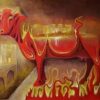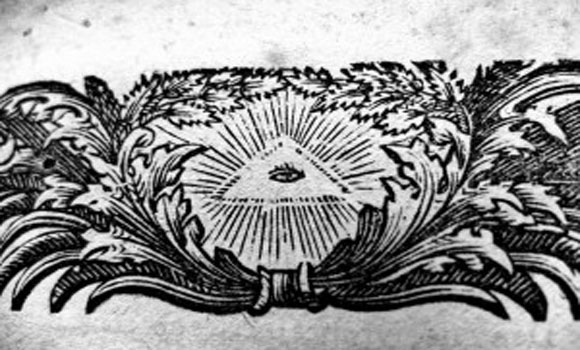A few years ago, I came across a treasure trove of ancient information found in a sealed jar in 1945 near the town of Nag Hammadi about 75-80 miles north of Luxor on the banks of the River Nile in Egypt. They are known as the Nag Hammadi Library, texts or scriptures and thanks to them other major pieces in the puzzle were revealed and my already developing conclusions confirmed.
The Nag Hammadi find included 13 leatherbound papyrus codices (manuscripts) and more than 50 texts written in Coptic Egyptian which were the work – with other ancient influences – of a people known as Gnostics. They were not a racial group so much as a way of perceiving reality under the heading of Gnosticism. This comes from the term gnosis or knowledge in the context of spiritual knowledge and awareness of reality as it really is. Gnosis is a Greek word that translates as secret knowledge, and Gnostic means ‘learned’. We have the saying in English about ‘using your nous’ or using your head/brain/intelligence; but to Gnostics spiritual awakening or ‘salvation’ could only be attained by expanding awareness beyond what they called nous and into pneuma (Infinite Self).
Humanity’s version of the intellect on which the whole crazy world is based is actually a shockingly low level of awareness which is lauded and feted as the fountain of knowledge. It’s more like a spout of ignorance. Gnostics were active in many locations and were targeted mercilessly by the Roman Church which felt severely threatened by the way the foundation of its own belief system was being turned on its head. What the Roman Church saw as its all-powerful God to be worshipped without question the Gnostics believed was the source of evil that created the material world – in my terms the ‘material’ world of the digital, holographic computer-like simulation. Gnostics could see through the illusion of ‘matter’ and I have no doubt they were helped in that understanding by the use of psychoactive potions that took them ‘out there’.
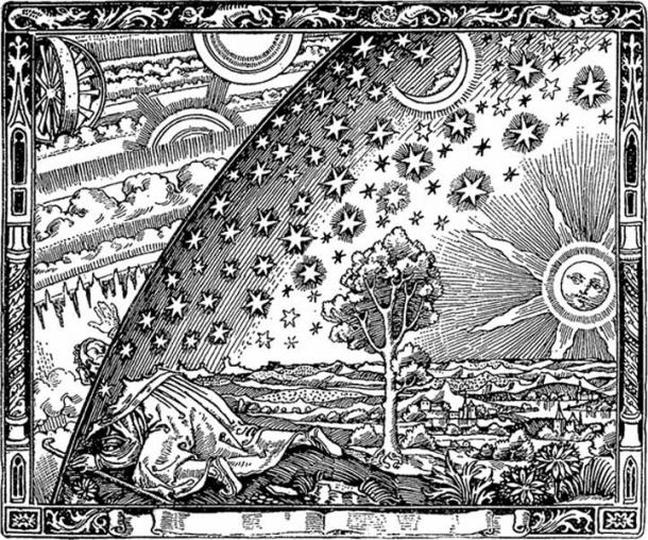
Gnostics could see through the illusion. The Flammarion engraving, Paris 1888 (public domain)
The Royal or Great Library of Alexandria in Egypt with its amazing collection of ancient knowledge and history was dominated by Gnostic thought. An estimated nearly half a million scrolls, manuscripts and documents were gathered from many locations including Assyria, Greece, Persia and India, as well as Egypt. Those with more expanded awareness were attracted to this oasis of open-mindedness and among them was a woman called Hypatia (about 350- 415AD).
She was an Athens-educated mathematician, astronomer and philosopher who taught the work of Greek philosophers Plato and Aristotle and was head of the Platonist school at Alexandria. One of her reported quotes confirms her openness of mind:
‘Reserve your right to think, for even to think wrongly is better than not to think at all.’
Many insights about reality were inspired by such a haven of freethought thousands of years before science’ allegedly discovered them for the first time. This included the understanding that the Earth goes around the Sun 2,000 years before it was established by the Polish mathematician and astronomer, Nicolaus Copernicus.

The Library of Alexandria (CC by SA 4.0)
How so much more enlightened humanity would be had the Gnostics and other open-minded scholars been left unmolested to go about their quest for discovery. Alas, that was not to be. The unfettered, uncensored, free-thinking pursuit of knowledge was bound to twist the knickers of the Roman Church tyranny and in 415AD a mob of bewildered suckers led by Cyril, Patriarch of Alexandria, attacked and essentially destroyed the Royal Library as it had been before. Hypatia was hacked to death.
The Library’s contents were lost in stages to a combination of fire and theft, and much of what was taken will be in the vaults of the Vatican to this day. Cyril was made a saint as with a long list of Roman Church mass murderers and crooks before and since. The attack that killed Hypatia fits with the estimated age of the Nag Hammadi manuscripts.
They are believed to date from between 350-400AD although it is said they are likely to be copies of earlier Greek versions dating to perhaps 120-150AD or earlier. Centuries after the assault on the Gnostics of Alexandria came the campaign against the Gnostic Cathars in southern France which ended with them being burned at the stake after the siege of the Castle of Montségur in 1244.
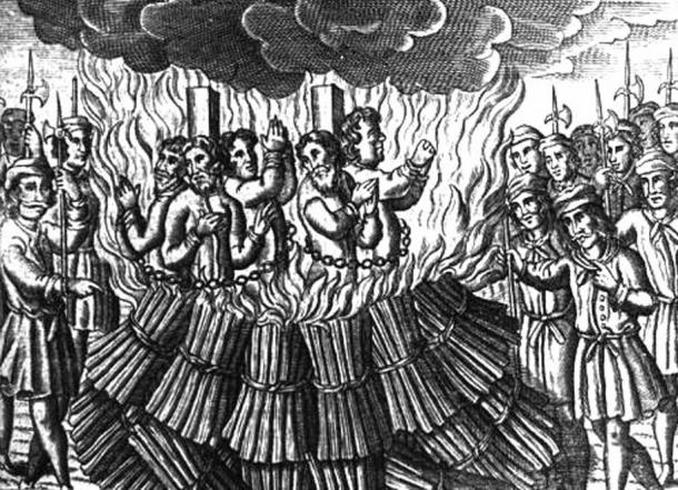
A depiction of the burning of Cathars by the Papal Inquisition in the Languedoc in late 12th to early 13th century (public domain)
Gnostic information has always terrified the Church and for good reason, as we are about to see. It was believed that the details of Gnostic belief had been lost thanks to the efforts of Rome, but then Nag Hammadi changed the game. A major point about these documents is that because they were hidden for so long they have not been twisted and tampered with like their religious counterparts to suit the authorities of the ‘time’. What the writers believed, the texts still say.
The Gnostic All That Is
Nag Hammadi manuscripts reveal why the Church quivered like a jelly at the Gnostic explanation of the world. I was often amazed reading them to see how themes, foundations and much detail synced with my own conclusions reached before I had ever heard of them. They speak of the ‘Father’ (Infinite Awareness, All-Possibility, All-Potential) and make the distinction between nous (mind) and pneuma (Infinite Self). An untitled text in the Nag Hammadi Bruce Codex says that ‘The All’ (all awareness, all that exists) is contained within the ‘Father’:
He is an incomprehensible one, but it is he who comprehends All. He receives them to himself. And nothing exists outside of him. But All exist within him. And he is boundary to them all, as he encloses them all, and they are all within him. It is he who is Father of the aeons, existing before them all. There is no place outside of him.

A page from the apocalypse of St. Peter, Nag Hammadi library (public domain)
This is what I call the All That Is or Infinite Awareness in awareness of itself – ‘the force that moves all things’. The Infinite is not even a form of energy, but pure awareness, a state of Isness. Energy comes from its imagination. You can appreciate why Gnostics would use the term Father to symbolise the concept for people, but now in the era of quantum physics and computerisation we can use modern analogies.
Father symbolism was encompassed by the Bible and Church and ‘he’ was transformed into a bloke on a throne. The word ‘aeons’ would be considered today to mean a long period of time, but to Gnostics aeons referred to what we might call bands of perception, reality and potential. Dictionaries define this meaning of aeon as ‘a power existing from eternity; an emanation or phase of the supreme deity’. Gnostic texts refer to the ‘Upper Aeons’ and ‘Lower Aeons’ in very different terms and they say that between the two is a curtain, veil or boundary. Upper Aeons are said to emanate directly from the unity of ‘The One’ – All That Is in awareness of itself – and can be symbolised as concentric circles expressing the Oneness of their Creator or Emanater. There is no separation or sense of it.
Upper Aeons are described by Gnostics as ‘The Silence’, ‘the silent Silence’, ‘the living Silence’, with its ‘Watery Light’. This is not the same as the light that we perceive in our reality which is a trap that can be likened to energetic flypaper; but that’s for later. Water is often used in the texts to symbolise the Upper Aeon realm of Oneness as in ‘… the waters which re above’, ‘… the waters which are above matter’ and ‘… the Aeons in the Living Water’. Upper Aeons are a reality (state of being) with no time or space. ‘Since the emanations are limitless and immeasurable’, as one text says, there can be no time or space. Upper Aeons are pure consciousness or awareness. They are also called Pleroma or ‘the totality’, ‘the fullness’ and the ‘perfection’ of ‘emanations of the Father’.
The Nag Hammadi Gospel of Truth says: ‘Therefore, all the emanations of the Father are pleromas, and the root of all his emanations is in the one who made them all grow up in himself.’ Upper Aeons are further described as the ‘Treasure-House’, ‘Store-House’, ‘Dwelling-Place’ and ‘Kingless Realm’. A text entitled the Tripartite Tractate says:
The emanation of the Totalities, which exist from the one who exists, did not occur according to a separation from one another, as something cast off from the one who begets them. Rather, their begetting is like a process of extension, as the Father extends himself to those whom he loves, so that those who have come forth from him might become him as well.
The creations (extensions/emanations) of Infinite Awareness in awareness of itself can be symbolised as the manifestations of Thought, but I prefer the term ‘creative imagination’. This describes what the Gnostics called the Upper Aeons – the realm of Infinite Imagination and therefore All-Possibility, All-Potential. Gnostics symbolised Infinite Imagination as the ‘Father’ and ‘The Thought’ as the Mother. They said the interaction of the two produced a third force or imagined creation/extension/reflection of itself which was symbolised as the Son.
A text entitled Apocryphon of John (‘Secret Writing’ of John) describes this concept:
For it is he who looks at himself [saw his reflection] in his light which surrounds him, namely the spring of the water of life. And it is he … who gazes upon his image which he sees in the spring of the Spirit. It is he who puts his desire [intent] in his water-light which is in the spring of the pure light-water which surrounds him.
And his thought performed a deed and she [the ‘Mother’] came forth, namely she who had appeared before him [his image/imagination] in the shine of his light. [She] came forth from his mind … This is the first thought, his image.

An illustration of creation by Phillip Medhurst (CC by SA 3.0)
From here what we call ‘Creation’ emerged from the imaginations of Infinite Awareness and its creations which are extensions of the same Infinite Awareness. Gnostic texts describe how the act of naming the creations of Infinite Imagination brings them into being. This is from the Gospel of Truth:
All the spaces are his emanations. They have known that they came forth from him, like children who are from a grown man. They knew that they had not yet received form, nor yet received a name, each one of which the Father begets …But the Father is perfect, knowing every space within him. If he wishes, he manifests whomever he wishes, by giving him form and giving him a name, and he gives a name to him, and brings it about that those come into existence.Upper Aeons are the realm of the ultimate ‘Creator’, or creative force/imagination, and it begs a question: If that is the case why is life so unpleasant – even shockingly bad – for so many in our reality? There is an answer to that.
This article is an extract from the book ‘Everything You Need to Know but Have Never Been Told’ by David Icke. Visit www.davidicke.com for more information.
